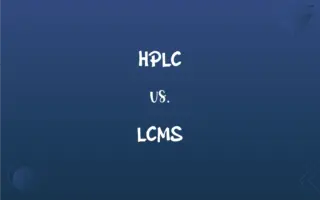Cholangitis vs. Cholecystitis: What's the Difference?
Edited by Aimie Carlson || By Harlon Moss || Published on February 14, 2024
Cholangitis refers to inflammation of the bile ducts. Cholecystitis refers to inflammation of the gallbladder.

Key Differences
Cholangitis is a condition involving inflammation of the bile ducts, typically caused by bacterial infection. Cholecystitis, in contrast, is characterized by inflammation of the gallbladder, often due to gallstones blocking the cystic duct.
Symptoms of cholangitis can include jaundice, fever, and upper abdominal pain. In the case of cholecystitis, symptoms commonly involve severe pain in the upper right abdomen, nausea, and vomiting.
Diagnosis of cholangitis often involves blood tests, imaging studies, and sometimes endoscopic examination of the bile ducts. Cholecystitis is usually diagnosed with ultrasound imaging, blood tests, and occasionally other imaging tests like CT scans.
Treatment for cholangitis typically involves antibiotics to combat the infection and procedures to relieve bile duct obstruction. Cholecystitis often requires gallbladder removal surgery (cholecystectomy), especially in cases of recurrent or severe inflammation.
Complications of untreated cholangitis can be severe, including sepsis and liver damage. In contrast, cholecystitis can lead to complications like gallbladder rupture or chronic gallbladder dysfunction.
ADVERTISEMENT
Comparison Chart
Definition
Inflammation of bile ducts
Inflammation of gallbladder
Common Cause
Bacterial infection, bile duct obstruction
Gallstones blocking cystic duct
Symptoms
Jaundice, fever, abdominal pain
Upper right abdominal pain, nausea
Diagnostic Methods
Blood tests, imaging, endoscopy
Ultrasound, blood tests, CT scans
Treatment
Antibiotics, bile duct relief
Gallbladder removal surgery
ADVERTISEMENT
Cholangitis and Cholecystitis Definitions
Cholangitis
Inflammatory response in the bile ducts due to obstruction.
The gallstone caused cholangitis by blocking the bile flow.
Cholecystitis
Inflammation of the gallbladder, usually acute.
The sudden severe abdominal pain was indicative of cholecystitis.
Cholangitis
Bacterial infection of the bile duct system.
Antibiotics were prescribed to treat the patient's cholangitis.
Cholecystitis
Gallbladder disease marked by pain and swelling.
Cholecystitis was the diagnosis after ruling out other abdominal issues.
Cholangitis
Acute inflammation of the bile ducts.
The patient was diagnosed with cholangitis after presenting with jaundice and fever.
Cholecystitis
Acute or chronic inflammation of the gallbladder.
Chronic cholecystitis may require surgical intervention.
Cholangitis
A liver-related infection affecting the bile ducts.
The doctor explained that untreated cholangitis could lead to liver complications.
Cholecystitis
Gallbladder disorder with potential complications.
If left untreated, cholecystitis can lead to serious health issues.
Cholangitis
Pathological swelling of the bile ducts.
MRI results confirmed cholangitis with visible swelling in the bile ducts.
Cholecystitis
A common gallbladder inflammation often caused by gallstones.
Gallstones were found to be the cause of her cholecystitis.
Cholangitis
(pathology) An inflammation of the bile duct.
Cholecystitis
Inflammation of the gallbladder.
Cholangitis
Inflammation of the bile ducts
Cholecystitis
(disease) An inflammation of the gall bladder.
Cholecystitis
Inflammation of the gall bladder
FAQs
What is cholangitis?
An inflammation of the bile ducts, often due to infection.
Can cholangitis lead to other health issues?
Yes, if untreated, it can cause liver damage and sepsis.
Is surgery necessary for cholangitis?
Not always; it depends on the cause and severity.
What causes cholecystitis?
Most commonly, gallstones blocking the cystic duct.
What are common symptoms of cholecystitis?
Severe upper right abdominal pain and nausea.
What tests are used to diagnose cholangitis?
Blood tests, imaging studies, and sometimes endoscopy.
How is cholecystitis treated?
Often with gallbladder removal surgery.
Can diet affect cholecystitis?
Yes, a high-fat diet can increase the risk.
How is cholecystitis diagnosed?
Typically through ultrasound and blood tests.
Can children develop cholangitis?
It's less common but possible, especially with congenital anomalies.
Are antibiotics effective for cholangitis?
Yes, they are a primary treatment for bacterial infection.
Does cholecystitis affect other organs?
It can affect the liver and pancreas if complications arise.
Is cholangitis a serious condition?
It can be, particularly if it leads to complications.
Is cholecystitis more common in certain age groups?
Yes, it's more common in adults, especially over 40.
Are there risk factors for developing cholangitis?
Yes, including bile duct stones and previous biliary surgery.
Is cholecystitis a chronic condition?
It can be either acute or chronic.
What lifestyle changes help with cholecystitis?
Dietary changes and weight management can be beneficial.
Can cholecystitis recur after surgery?
After gallbladder removal, cholecystitis itself doesn't recur.
What are the long-term effects of cholangitis?
Chronic cholangitis can lead to scarring and liver damage.
Can lifestyle changes prevent cholangitis?
They can help, especially in managing associated risk factors.
About Author
Written by
Harlon MossHarlon is a seasoned quality moderator and accomplished content writer for Difference Wiki. An alumnus of the prestigious University of California, he earned his degree in Computer Science. Leveraging his academic background, Harlon brings a meticulous and informed perspective to his work, ensuring content accuracy and excellence.
Edited by
Aimie CarlsonAimie Carlson, holding a master's degree in English literature, is a fervent English language enthusiast. She lends her writing talents to Difference Wiki, a prominent website that specializes in comparisons, offering readers insightful analyses that both captivate and inform.







































































